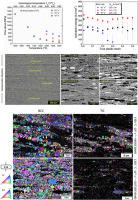一种超细晶多相CrMoNbTiW难熔高熵合金的高温变形行为及显微组织演变
IF 9.3
1区 材料科学
Q1 MATERIALS SCIENCE, MULTIDISCIPLINARY
引用次数: 0
摘要
研究了粉末冶金法制备的等原子CrMoNbTiW耐火高熵合金(RHEA)的变形行为。合金以BCC相为主,TiC相和Cr₂Nb相次之。单轴压缩试验在1000到1350°C的温度下进行,应变率为10⁻¹到10⁻³。利用arrhenius型幂律分析了流变应力数据,发现表观活化能和应力指数与温度、应变和应变速率有很强的相关性。超细晶组织和二次相有利于连续动态再结晶。然而,在所有变形条件下都观察到流动局部化。纳米压痕分析表明,不同相具有不同的变形行为,富w的BCC相比TiC相具有更高的变形抗力。这些发现强调了分析多相材料变形后微观结构对阐明潜在变形机制的重要性。本文章由计算机程序翻译,如有差异,请以英文原文为准。


High temperature deformation behavior and microstructural evolution of an ultrafine-grained and multiphase CrMoNbTiW refractory high entropy alloy
The present study investigates the deformation behavior of an equiatomic CrMoNbTiW refractory high entropy alloy (RHEA) synthesized via powder metallurgy. The alloy displayed a dominant BCC phase with secondary TiC and Cr₂Nb phases. Uniaxial compression tests were performed at temperatures ranging from 1000 to 1350 °C and strain rates of 10⁻¹ to 10⁻³ s⁻¹. The flow stress data were analyzed using an Arrhenius-type power law, revealing a strong dependence of the apparent activation energy and stress exponent on temperature, strain, and strain rate. The ultrafine-grained microstructure and secondary phases facilitated continuous dynamic recrystallization (CDRX). However, flow localization was observed under all deformation conditions. Nanoindentation analysis indicated distinct deformation behaviors among the different phases, with the W-rich BCC phase exhibiting higher deformation resistance compared to TiC. These findings highlight the importance of analyzing the post-deformation microstructure of multiphase materials to elucidate the underlying deformation mechanisms.
求助全文
通过发布文献求助,成功后即可免费获取论文全文。
去求助
来源期刊

Acta Materialia
工程技术-材料科学:综合
CiteScore
16.10
自引率
8.50%
发文量
801
审稿时长
53 days
期刊介绍:
Acta Materialia serves as a platform for publishing full-length, original papers and commissioned overviews that contribute to a profound understanding of the correlation between the processing, structure, and properties of inorganic materials. The journal seeks papers with high impact potential or those that significantly propel the field forward. The scope includes the atomic and molecular arrangements, chemical and electronic structures, and microstructure of materials, focusing on their mechanical or functional behavior across all length scales, including nanostructures.
 求助内容:
求助内容: 应助结果提醒方式:
应助结果提醒方式:


